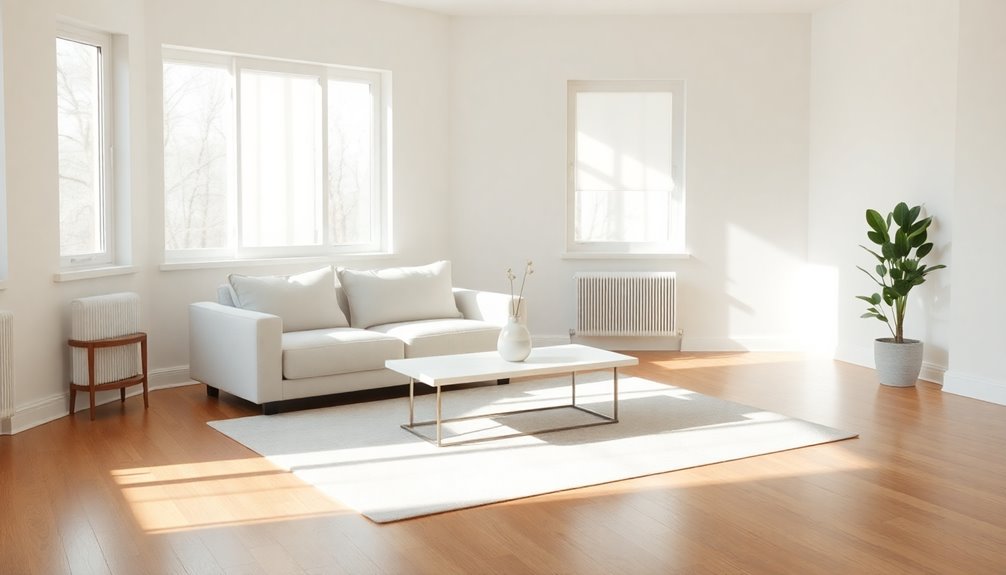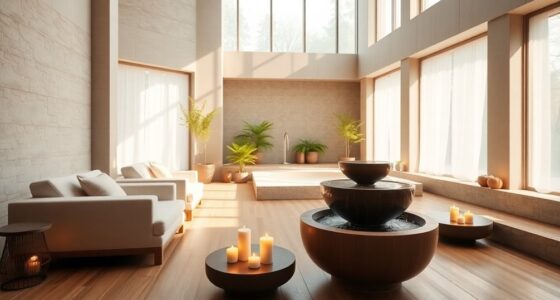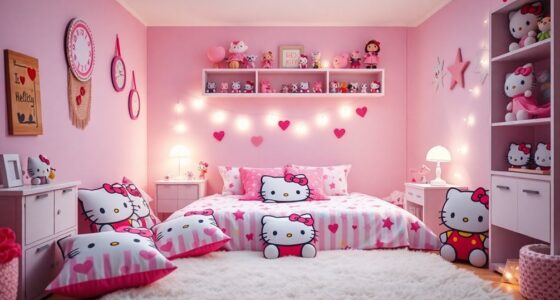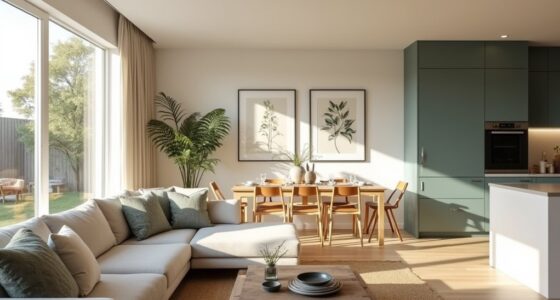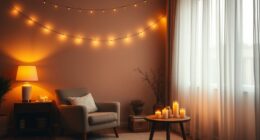Minimalist interior design lets you create calming spaces by focusing on simplicity. Start with a simple color palette featuring neutral tones like white and beige, complemented by natural materials like wood and stone. Incorporate clean lines for visual harmony, allowing your rooms to feel more spacious and inviting. Keep accessories to a minimum; each piece should serve a purpose and shine amid the simplicity. Utilize negative space effectively, promoting organization and tranquility. With thoughtful choices, you'll foster a serene atmosphere that resonates. There's much more to explore on how to enhance your minimalist style further.
Key Takeaways
- Embrace a simple color palette with neutral tones to create a soothing and timeless atmosphere.
- Incorporate clean lines and geometric shapes to enhance visual harmony and a sleek aesthetic.
- Limit accessories to essential items, emphasizing quality and purpose to reduce visual clutter.
- Utilize negative space effectively by keeping surfaces clear and incorporating interesting textures for depth.
- Choose natural materials like reclaimed wood and stone to add warmth and character while promoting sustainability.
Embracing a Simple Color Palette

Embracing a simple color palette is essential for achieving a minimalist interior design that feels calm and inviting. By selecting neutral tones or subtle hues, you create a cohesive look that enhances the overall tranquility of the space. This approach not only simplifies the visual clutter but also opens up opportunities for incorporating unique textures and materials. For those interested in further exploring these concepts, interior design learning games can provide an engaging way to experiment with color schemes and layouts, enhancing one’s understanding of minimalist principles.
You'll want to focus on neutral tones like white, beige, gray, and taupe, which create a soothing atmosphere. Natural hues, such as wood and stone, can add warmth and texture without overwhelming the space. Additionally, neutral colors are versatile and timeless, making them suitable for various design styles. The use of a functional layout can further enhance the simplicity and efficiency of the space.
Monochromatic schemes work well too; using variations of a single color fosters harmony. Consider pops of color like deep blues or vibrant yellows to inject energy while maintaining simplicity.
Lastly, contrasting combinations, like black and white, can provide striking visual interest. By carefully selecting your colors, you create an environment that's both peaceful and aesthetically pleasing.
Importance of Clean Lines
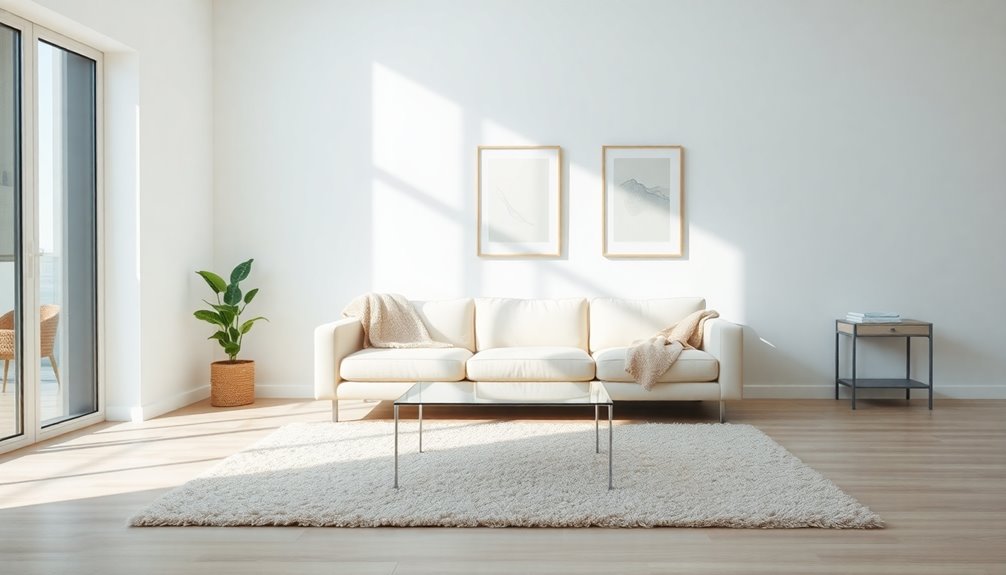
A simple color palette sets the stage for minimalist design, but it's the clean lines that truly define the space.
Clean lines create order and visual harmony, essential for achieving that uncluttered aesthetic. They enhance the visual appeal, giving your home a sleek, elegant look while serving practical purposes. You can use geometric shapes, straight lines, or even subtle curves to achieve this effect. Additionally, natural elements can be integrated to further enhance the calming effect of clean lines in your space. Incorporating bohemian style elements can also add a touch of warmth and personality to minimalist interiors.
Clean lines also make a space feel larger, inviting natural light to flow freely and fostering a sense of tranquility.
When choosing furniture and materials, opt for items that feature these clean lines, avoiding ornate details. This consistency will help you maintain a cohesive and serene environment that embodies minimalist elegance.
The Power of Fewer Accessories
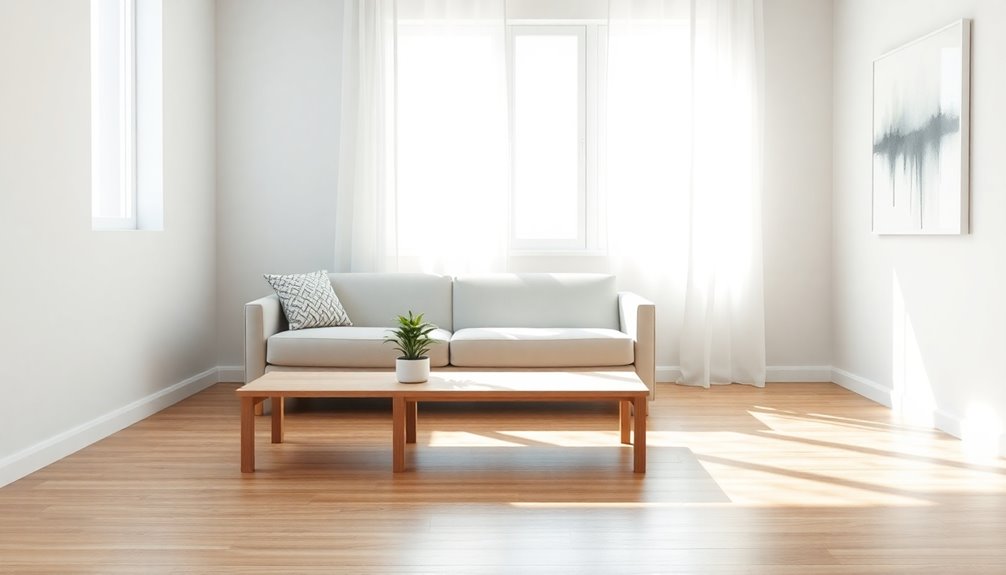
When you minimize the number of accessories in your space, you create an environment that feels more open and serene.
Fewer accessories reduce visual clutter, allowing essential elements to shine and enhancing your overall aesthetic. You'll find that maintaining a minimalist space simplifies upkeep, promoting calmness and organization. Additionally, incorporating natural materials can further enhance the tranquil ambiance of your minimalist design.
By focusing on quality over quantity, each item serves a purpose, contributing to a clean and balanced look. A well-chosen few can make a significant impact, standing out against a neutral background. This approach not only highlights architectural features but also ensures your design remains timeless and emphasizes the importance of negative space.
Ultimately, a minimalist selection of accessories enhances functionality, making your space practical and efficient while inviting a sense of tranquility.
Utilizing Negative Space Effectively
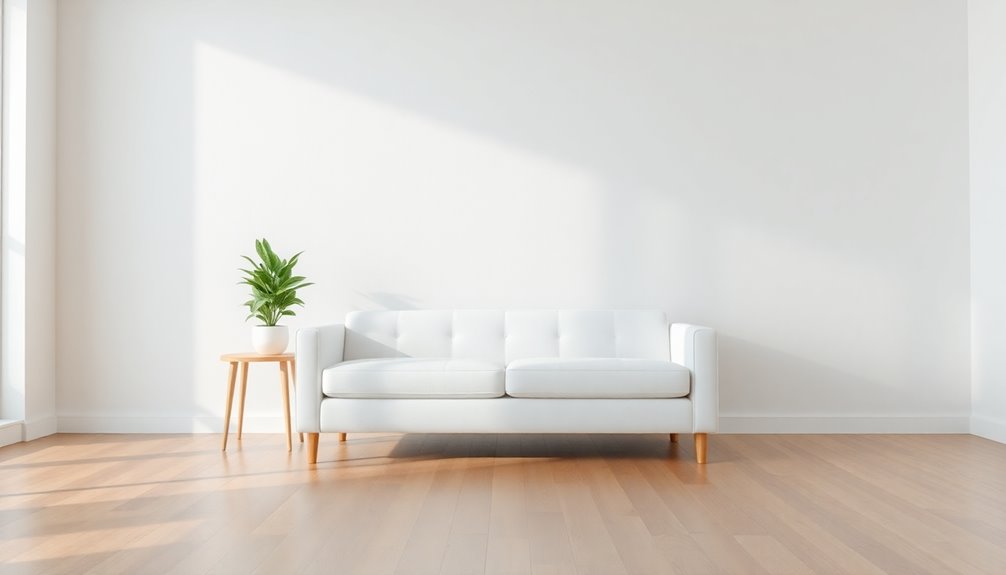
While creating a minimalist interior, effectively utilizing negative space is crucial for achieving a serene and balanced design. Embrace simple and clean lines, opting for neutral color palettes like whites and grays to foster a calming atmosphere.
Keep surfaces unadorned and decluttered, allowing the space to breathe and promoting tranquility. Incorporate interesting shapes and textures in the negative space to add depth without overwhelming the design. Use asymmetrical arrangements to create visual interest and balance.
Maximize natural light to enhance the feeling of openness, while ensuring clear pathways to avoid overcrowding. Remember, every item should serve a purpose, reinforcing the minimalist ethos and allowing negative space to shine. Negative space is not merely the absence of items; it is a purposeful design element that enhances both aesthetic appeal and functionality of a space.
Choosing Natural Materials

Choosing natural materials for your minimalist interior not only enhances the aesthetic but also fosters a deeper connection to the environment. Incorporating elements like reclaimed wood, stone countertops, and organic textiles creates warmth and unique character in your space.
Think about using bamboo for its sustainability and durability, or clay and terracotta for a rustic touch. Natural materials exude a timeless elegance that complements various styles, ensuring lasting appeal. Sustainable materials are essential for promoting a harmonious relationship with nature in your home.
You'll appreciate the inviting atmosphere they create, contrasting beautifully with harder surfaces. By choosing eco-friendly options like cork or sustainably sourced hardwood, you're also supporting a sustainable lifestyle.
Ultimately, these choices promote well-being and a harmonious relationship with nature in your home.
Frequently Asked Questions
How Can I Incorporate Personal Items in a Minimalist Design?
To incorporate personal items in a minimalist design, start by selecting meaningful pieces that resonate with you, like family heirlooms or unique artwork.
Use multi-functional items to maximize space and keep the design balanced. Display these items thoughtfully to create focal points while maintaining negative space.
Add texture and subtle color accents to enhance warmth. Regularly reassess your collection, ensuring each piece serves a purpose and contributes to the overall aesthetic.
Is Minimalist Design Suitable for Small Spaces?
Yes, minimalist design is perfect for small spaces! You can declutter to create a clean environment, making it feel larger.
By using multi-functional furniture, like a sofa bed or storage ottoman, you maximize utility without overcrowding.
Strategic placement of furniture helps define zones while maintaining flow.
Emphasizing natural light and a neutral color palette can enhance openness.
Ultimately, minimalist design brings simplicity and functionality, making your small space feel inviting and spacious.
What Are Common Mistakes in Minimalist Interior Design?
When diving into minimalist interior design, you might stumble into common pitfalls. Accumulating too many small pieces can clutter your space and distract from its simplicity.
Forgetting to add layers and textures can make it feel cold. Also, avoid chaotic color schemes; stick to a soothing palette.
Lastly, not personalizing your space can lead to a sterile environment. Remember, balance and personal touches are key to achieving a harmonious minimalist design.
How Do I Maintain a Minimalist Space Over Time?
To maintain a minimalist space over time, you've gotta stay proactive.
Schedule regular decluttering sessions and stick to the 'one in, one out' rule—it works wonders!
Organize thoughtfully by designating storage spaces and using multi-functional furniture.
Before buying anything new, assess if it's truly necessary to avoid clutter.
Lastly, inspect your spaces periodically to keep everything tidy.
Consistency is key; make it a routine, and you'll enjoy your minimalist space for years!
Can I Mix Minimalist Design With Other Styles?
Yes, you can definitely mix minimalist design with other styles!
Start by establishing a cohesive color palette that complements your minimalist base. Balance patterns and textures for visual interest, ensuring they don't overwhelm the space.
Embrace unexpected pairings, like vintage pieces with modern decor, to add character.
Don't shy away from personal touches, as they can make your space feel unique while maintaining that minimalist essence.
Experiment, and trust your instincts!
Conclusion
Incorporating minimalist interior design into your space can truly transform it into a serene sanctuary. By embracing a simple color palette, clean lines, and fewer accessories, you're creating an environment that feels open and inviting. Remember, less is often more, and utilizing negative space effectively can make a world of difference. So, go ahead and choose natural materials that resonate with you, and watch your home become a breath of fresh air. You'll feel right at home!
